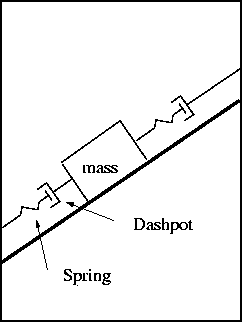Mass-Spring-Dashpot on a wedge model of the mechanics

-
 Using Newton's second law -- Forces
on the slab are
ma = F
Using Newton's second law -- Forces
on the slab are
ma = F
- Gravity
- Spring above - models tension
- Spring below - models compression
- Dashpots - model viscoelasticity
-
 Using linear models of the
springs and dashpots
mx'' + c x' + (ku-kd) x =
mg sin(angle)
Using linear models of the
springs and dashpots
mx'' + c x' + (ku-kd) x =
mg sin(angle)
- x(t) is position
- c is the viscous damping coefficient
- ku, kd are the spring stiffness coefficients
- Assumed to be constant
- Hooke's law springs
- Resting lengths are zero (should vary slowly with time)
-
 Solutions of the
linear problem
Solutions of the
linear problem
- Equilibrium position
x = mg sin(angle)/(ku-kd)
- If c > 0 then all
solutions but the equilibrium solution are transient.
- Choose c big enough so the system is overdamped.
-
 This model does not predict
avalanches or depend on crystal type
This model does not predict
avalanches or depend on crystal type
- Can be used as a basis for more complex models
- Hooke's law spring will be abandoned

 Using Newton's second law -- Forces
on the slab are
Using Newton's second law -- Forces
on the slab are
 Using linear models of the
springs and dashpots
Using linear models of the
springs and dashpots
 Solutions of the
linear problem
Solutions of the
linear problem
 This model does not predict
avalanches or depend on crystal type
This model does not predict
avalanches or depend on crystal type
